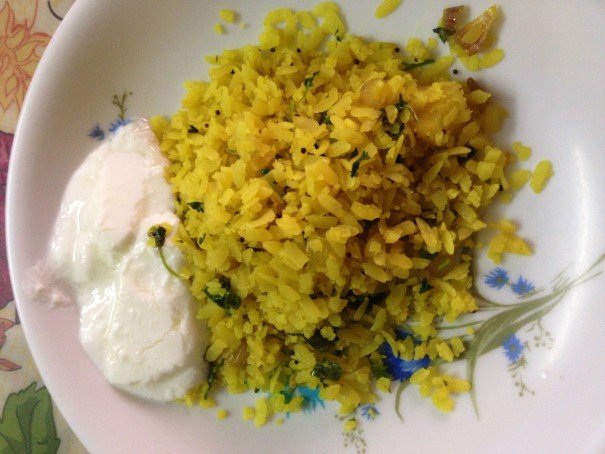
It’s Not Just Rice

It’s Not Just Rice
Pohe in Hyderabad
This plate of pohe means that I’m home. Back from the field — the sweaty days in Tilonia, and the dusty Delhi commutes. Back in my uncle’s apartment in Hyderabad, on the same plot of land where my mom grew up. I’m tanner and leaner and tired down to the pit of my stomach and there’s nothing I want more than this little hill of flattened rice, soaked to maximum fluffiness, tossed with cumin seeds and turmeric and coriander and salt. My favorite part, the roasted peanuts, I distribute evenly through every spoonful.
I’ve had pohe dozens of times on the road these past few months—poured into cones made of newspaper by wiry street vendors in sleeveless undershirts. In every state I visit they’ve given it a twist and a name of its own, because states in India can be as different as countries, their borders distinguished by hills and bloodlines.
In Gujarat it’s the nasalized pauwa. They top it with pomegranate seeds and fried sev, or with tiny slices of potato. In Udaipur, in Rajasthan, there’s a generous garnish of fresh coriander leaves on the bright yellow mix. And on the train rides between my destinations, families share steel tupperware of pohe in its dry, flaky form, mixed like trail mix with peanuts and raisins and cardamom. When I was little I used to eat all the peanuts.
Here at our Marathi speaking home in Hyderabad we call it pohe and eat it simple and hot and just slightly salty. Today I devour my breakfast quickly, hungrily with a dollop of cold, homemade yogurt and a bowl of papaya. And I think about the time when in the middle of a squabble with my grandfather I made him a huge bowl of pohe and he stopped arguing and said it was cooked with bhav (passion). After that we both sat on a sofa and sipped tea and talked about his village until it was time for lunch.